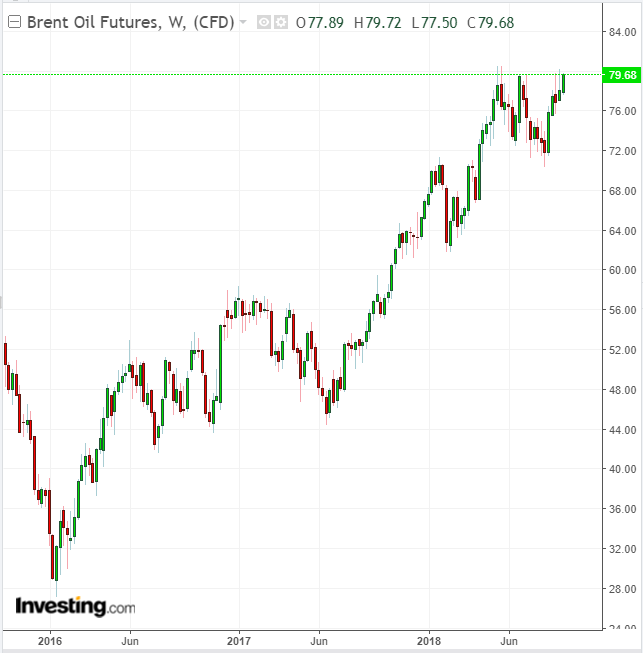Brent, the European crude oil benchmark, has been flirting with $80 per barrel for the past week. Last week, it briefly spiked above $80, triggered by the weekly US Energy Information Agency (EIA) report that showed a drawdown of over 5 million barrels of stockpiled oil.

Just two years ago the price of Brent was only $45 per barrel and analysts were wondering if low oil prices might become a more permanent market fixture.
Now that prices are heading upwards of $80, is it safe to declare the era of low oil prices over? Could we soon see oil climbing the $90 or $100 per barrel and gasoline prices topping $4 per gallon for consumers in the United States?
Here are two different takes:
1. Yes, oil prices will climb higher.
- Growth rates in the US fracking industry are starting to fall. A lack of pipelines is causing shale oil companies in the Permian and nearby regions to hold off drilling new wells. Without consistent growth in this area, oil prices will rise.
- Iran’s oil production and its oil exports are slowing as a result of the new US sanctions that will take effect on November 4. According to Tanker Trackers, Iranian exports are already down to 1.578 million barrels per day in September. This represents a 23.4% drop from August. Some analysts think the Iran sanctions could take 1.5 million barrels per day off the global market and that other producers won’t be able to make up the difference.
- Venezuela’s oil production is tanking and will continue to collapse as the country faces an economic crisis so great the government cannot keep the lights on. According to Platts, Venezuela is only producing 1.2 million barrels per day—down from 1.97 million barrels per day in 2017.
- Russia won’t say whether it will increase production until it meets with Saudi Arabia and other oil producing countries next Sunday in Algeria. OPEC and its partners could very well recommend that OPEC maintain current production levels when the group meets formally at the beginning of December. A failure to increase production could send oil prices soaring in anticipation of a future shortage.
- Saudi Arabia says it is “comfortable” with seeing Brent crude prices rise to above $80 in the short term. This may indicate that Saudi Arabia does not plan to increase its oil production over the next several months.
2. No, we aren’t about to see sky-high oil prices.
- Growth rates in the US fracking industry have indeed started slowing, but production is still strong and many shale oil companies are shipping their crude oil by rail or truck. As a result, producers are offering discounts of up to $14 per barrel. Not only that, but WTI is almost $10 lower than the price of Brent. The discounts US producers are forced to offer will keep WTI prices low, even as Brent rises. US pipeline capacity will grow throughout 2019 and US production and exports will grow as well, pushing global prices down.
- Iran’s segment of the oil market is shrinking, but it is still shipping oil to China, India, Turkey, Italy and Spain. Iran is also helping its Chinese and Indian customers avoid exposure to US sanctions by using its own fleet to ship its oil and providing insurance for that oil. Meanwhile, the EU is creating a financial workaround that could provide companies with a way to transfer funds to Iran in exchange for oil. This could mean more Iranian oil will remain on the market than analysts are now forecasting.
- Platts may have reported that Venezuela only produced 1.2 million barrels per day in August, but Reuters reported higher oil production—nearly 1.5 million barrels per day—in July. In additional, Venezuela’s oil minister claims the country will increase its production by 640,000 barrels per day in the coming months. More oil from beleaguered Venezuela would help keep a lid on oil prices.
- Russia claims it has the capacity to increase its oil production by at least 300,000 barrels per day and is ready to do so after the September 23 meeting between OPEC and non-OPEC oil ministers.
- Saudi Arabia and OPEC producers already increased oil production in August by 420,000 barrels per day and Saudi Arabia has additional spare capacity it has pledged to bring online if needed. There has been a great deal of discussion between Saudi Arabia and the United States that suggests Saudi Arabia will increase production to avoid sending oil prices up before election day.
The reality will likely fall somewhere between these two extremes:
US production will keep WTI prices low, but Venezuelan production will continue to drop. Somewhere around 1 million barrels per day of Iranian oil will probably come off the market due to sanctions, but China, Turkey and India will continue to import some Iranian oil. OPEC and Russia will probably decide to increase production, though they will not be able to entirely compensate for the decline in Iranian and Venezuelan oil exports.
But at the same time, speculation will continue to push oil prices higher even when the fundamentals show that the market is well-supplied or even slightly over-supplied.
